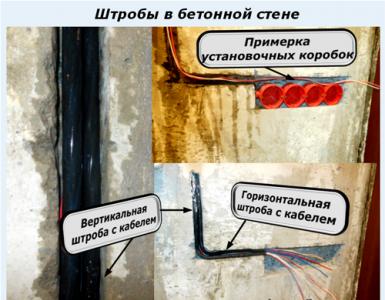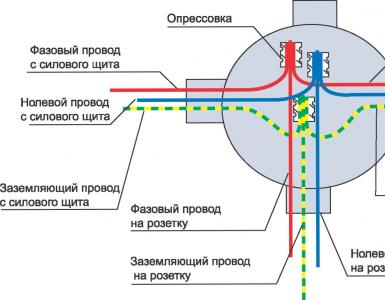Bathroom hood: how to install
The presence of a properly equipped ventilation system in the bathroom allows you to remove excess moisture that accumulates in the room. As you know, too much humidity provokes the development of fungus and mold, which have a detrimental effect on humans. Therefore, the hood is an integral part of the bathroom. Let's look at how to install a hood in the bathroom below.
Exhaust hood in the bathroom - installation advantages
Having a hood in the bathroom has the following advantages:
1. Preservation of wall and ceiling finishes. If there is no hood in the bathroom, then moisture begins to accumulate in the room. This, in turn, leads to the formation of mold and mildew on the walls and ceiling, the finish begins to deteriorate and the room needs repairs.
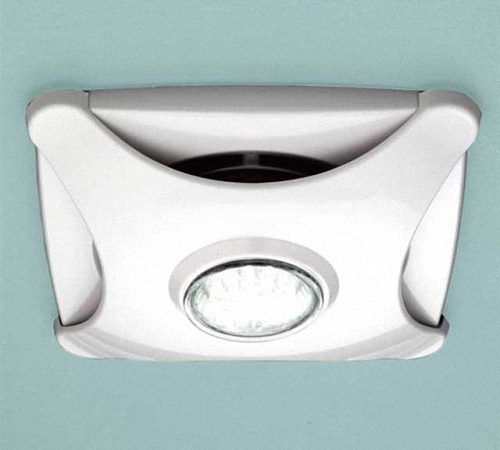
2. Comfortable conditions for staying in the bathroom. In addition, the hood promotes constant air circulation in the room. This way, when you enter the bathroom, you feel comfortable.
3. A variety of hoods allows you to choose the best option for your room. Since hoods vary in power, type and principle of operation, they have a modern design and fit perfectly into any interior.
4. Installation of the device is done quite quickly; it is not necessary to hire a specialist to carry it out; it is enough to carefully study the operating instructions for the device and recommendations for installing a hood in the bathroom.
5. Automatic switching on of most hoods makes their operation easier, and modern built-in motion sensors and timers allow you to regulate the microclimate in the room without human intervention.
6. Low electricity consumption is explained by automatic adjustment of the hood on and off.
7. The presence of a check valve allows you to avoid the appearance of an unpleasant odor in the room, which comes from the street or into the bathroom.
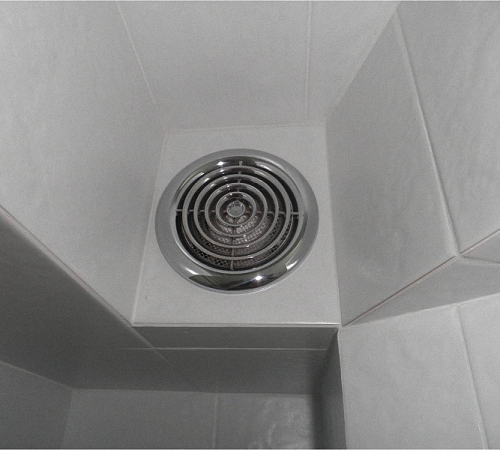
8. Low noise production is another important advantage of installing a hood in the bathroom. Modern devices produce quite little noise, which ensures a comfortable stay in the room, and, importantly, in a small apartment, especially at night, the sound of the hood is practically inaudible.
9. Duration of operation - if you choose a high-quality hood, it will serve its owners for more than ten years. No additional maintenance or repair required.
Exhaust hood in a bathroom in a private house - types and features
Depending on the type of air exchange, ventilation in the bathroom is of two types:
- natural;
- forced.
The first option involves performing an air exchange due to the fact that there is air of different temperatures in the bathroom and outside. Air exchange occurs through the hole in the wall on which the ventilation grille is placed. However, this ventilation is ineffective if the air outside is warmer than indoors. In addition, when bathing in the bathroom, there is a risk of getting sick due to the presence of drafts. Therefore, it is preferable to choose forced ventilation for the bathroom.
In order to provide forced ventilation, you will need to install a special device in the form of a hood. Namely, it promotes air exchange in the bathroom. Installation of this device is carried out in the ventilation system, if available, or directly in the wall. Thus, the hood takes air from the room, and fresh air enters it through a door or window.
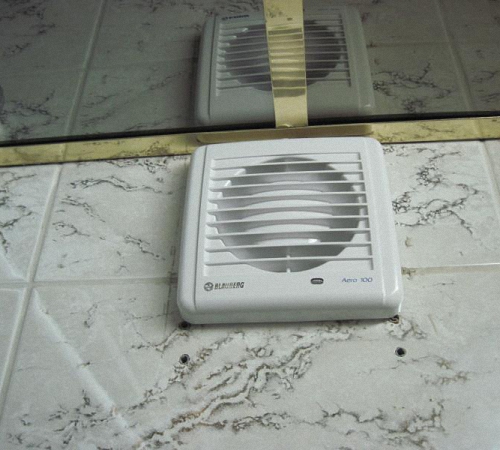
Depending on the functional features of the devices, the ventilation system in the bathroom can be:
- exhaust - the main device of which is a hood that sucks air from the room;
- supply - natural ventilation system;
- combined - the most effective and popular type of ventilation in the bathroom.
Depending on the presence of channels, the ventilation system is of two types:
- ductless - simpler, the hood is installed directly into a hole made in the wall;
- the duct option is popular if the building already has a duct ventilation system; in this case, the fan is installed at the beginning of the ducts, while taking into account the fact that you should definitely choose hoods with a check valve.

Hood in the bathroom - dimensions, features of choice
Before you begin installing an exhaust fan in the bathroom, you need to calculate the power of the device and select its model. We invite you to familiarize yourself with the features of calculating the performance of an exhaust fan for a bathroom:
F=v[(5….10), where:
- F - productivity value;
- v is the volume of the bathroom itself.
In parentheses is the value of the coefficient that indicates the frequency of use of the bathroom.
For example, the length of your bathroom is 4 m, and the width and height are 3 and 2, to calculate the volume, all these values are multiplied together, so you get 4x2x3 = 24 cubic meters. If the bathroom is designed for one person who showers twice a day, then it is enough to multiply this value by 5. And so, depending on the frequency of use of the bathroom, choose the appropriate coefficient. As a result, we get a hood with a capacity of about 120 units.

Please note that installing this device in a bathroom is absolutely safe. In most cases, manufacturers take into account the fact that the hood is installed in a room with high humidity and equip it with additional protection against splashes. When choosing a hood, this condition must be taken into account. The safety and moisture resistance class of the device is designated IP; the safety of the device depends on the value of this figure.
In addition, if you plan to install a hood in the bathroom, keep in mind that under the door or in another place you need to create a gap that will provide additional air supply to the bathroom.
It would be a good idea to purchase a device that contains motion sensors, timers, humidity regulators, etc. These devices greatly simplify the operation of the hood and make it work efficiently, without human intervention.
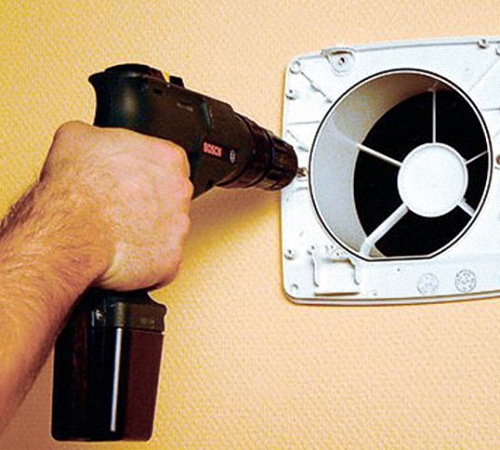
An exhaust hood in the bathroom with a check valve helps prevent foreign odors, debris or dirt from entering the room from the street. Therefore, when choosing a bathroom hood, it is best to give preference to a device with a check valve.
In addition, the technical characteristics of the hood indicate its noise level; try to buy models with the lowest ratings. Although, in order to provide additional sound insulation, ventilation shafts are treated with special materials, and a device in the form of a sound absorber is mounted near the hood.
The choice of a particular bathroom hood should be based on the parameters of the room itself, the frequency of use of the bath or shower. Therefore, to obtain a high-quality result, try to take into account all the individual parameters of the bathroom when purchasing an exhaust fan.

The most important factor in the correct installation of a hood in a bathroom is its safety, since a bathroom is a room with high humidity, and the hood should under no circumstances come into contact with water. We do not recommend giving preference to cheap models that can harm your health.
Before purchasing a product, you will need its technical certification and documents confirming its compliance with all fire safety standards. If the bathroom is large enough, it is recommended to install two hoods in it rather than installing one that is too powerful, since its operation will be less efficient.
1. It is recommended to install the hood in the bathroom under the ceiling or at a distance of no more than 20 cm from it. Try to ensure that the hood is located opposite or obliquely from the door. Thus, it will be possible to organize an additional flow of air after it is taken in using a hood.
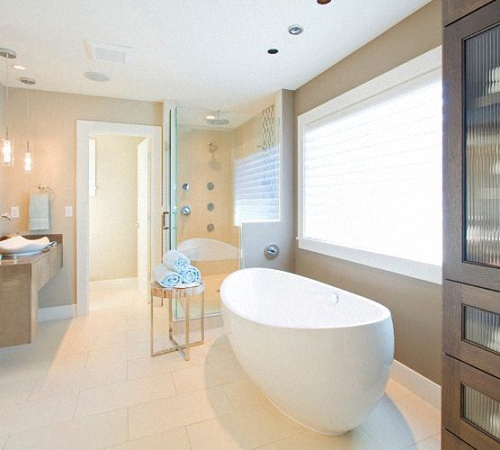
2. Please note that the correct choice of location for installing the hood directly affects its performance and the quality of functioning of the ventilation system, therefore the installation of this device should be treated with special responsibility. Despite the fact that the hood may be the most expensive and high-quality, violation of its installation technology will lead to a decrease in its efficiency.
3. If the bathroom already has a ventilation duct, then the hood should be installed in it. However, to expand it, it is recommended to use tools such as a hammer, chisel and grinder.
4. To fix the fan in the ventilation opening, use liquid nails, special fasteners or self-tapping screws. When choosing a mounting method, be guided by the individual parameters of the room.
5. When the fan is installed correctly, it is completely in the ventilation hole. There is a ventilation grille on the outside of the wall. When choosing a hood for the bathroom, make sure that the ventilation grille fully matches the overall style of the interior or is at least made in the same color scheme.
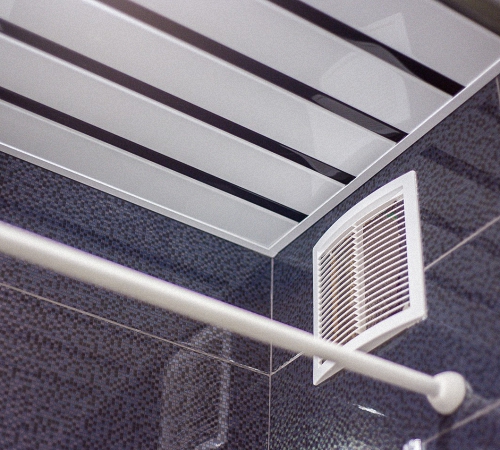
6. To further seal the joint between the grille and the wall and at the same time reduce the noise output of the device, you should use a silicone-based sealant. It is applied to the surface of the grille before fixing it to the wall.
7. To enable the fan to be turned on and off manually, it is connected to a separate switch. Although it is possible to connect the hood to a two-key switch, one key of which is responsible for turning on the light in the bathroom, and the second for the operation of the hood.
Tip: Before fixing the ventilation grille, we recommend checking the correct installation of the hood in the bathroom and its functionality.
Installation of extractor hood in the bathroom - technological features
Before making a hood in the bathroom, you should determine the presence or absence of a ventilation hole in it. If this is present, then the hood is mounted directly into it, otherwise, it is necessary to create a hole in the wall or ceiling to install the hood. Learn more about installing a hood in the bathroom with your own hands from the instructions:
1. Consider the option of having a ventilation duct in the bathroom. In this case, the grille is removed from it, and then the channel is checked for operability. Please note that this condition is mandatory, otherwise, installing a hood on a non-functioning ventilation duct will be ineffective.
2. If there is debris, dirt, or dust in the channel, you should definitely clean it. For these purposes, you will need to have a special tool or perhaps even hire a team of specialists to perform such work.

3. When choosing a fan, you should first consider the size of the ventilation hole. That is, the differences between the size of the fan and the hole should be minimal.
5. Using dowels or special polymer-based glue, fix the fan in the wall. It is first recommended to connect it to electricity and check its functionality.
Tip: When choosing a location for installing the fan, try to place it away from the shower, the place where it comes into contact with water, or the floor. Since installing a hood at the bottom of the wall is ineffective.
During operation of the hood, one should not forget that it is necessary to periodically clean the filters located under the ventilation grille.
How to install a hood in a bathroom video:


